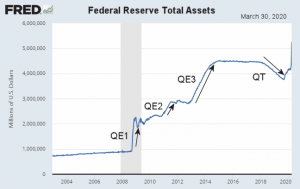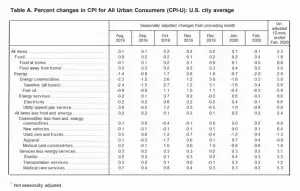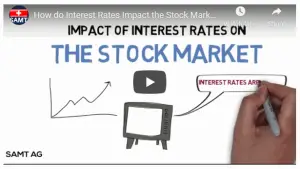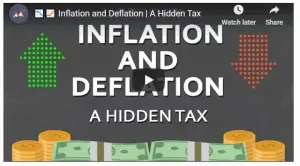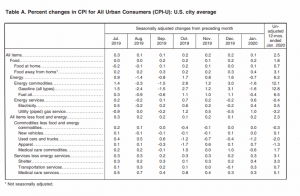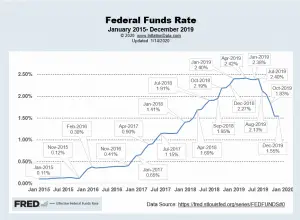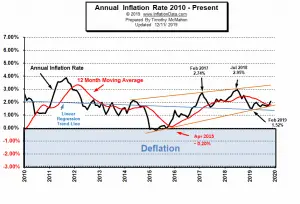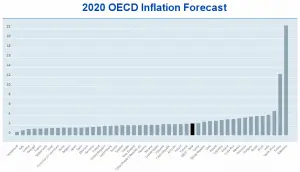By law banks are required to maintain a certain percentage of their assets in reserves at any given time. This money is held at the Federal Reserve bank and is called the “Reserve Requirement”. Generally, this money does not earn any interest. But, any money over and above this minimum can be loaned to other banks to who might not have enough reserves. The rate that banks can charge each other is called the “Federal Funds rate” or “Fed Funds Rate”. The monetary policy-making body of the Federal Reserve System, is called the “Federal Open Market Committee” or “FOMC”. The FOMC meets eight times a year to discuss the economy and decide on any changes to monetary policy. One of the major … [Read more...]
Will the $2 Trillion Covid-19 Stimulus Cause Inflation?
The current round of massive Corona Virus easing began Monday March 16th, 2020, with the FED buying $40 billion in Treasuries and then buying another $50 billion in Treasuries on Tuesday. By Thursday morning, it had upped the plan to $75 billion PER DAY and added $10 billion in mortgage securities. By Friday morning, the Fed had decided to buy $107 billion worth of Treasuries and mortgage-backed securities. In its first week, the FED purchased $317 billion worth of assets, which is slightly faster than the Fed balance sheet grew at the height of the 2008-2009 financial crisis. Initially, the Federal Reserve estimated purchases of $500 billion but FED chief Jerome Powell said the initial … [Read more...]
February Inflation Falls to 2.33%
The U.S. Bureau of Labor Statistics (BLS) released its February Inflation report on March 11th, 2020, for the 12 months through the end of February 2020. Annual Inflation Falls Annual inflation fell from the high set at 2.49% in January to 2.33% in February. CPI Index in February was 258.678 up from January's 257.971, December was 256.974, November was 257.208 down from October's 257.346 Monthly Inflation for January was 0.39%, while February was 0.27% down from 0.42% in February 2019. Next release April 10th Currently, the inflation rate is above the FED's target 2% rate. But the FED is concerned with a market meltdown due to falling Oil prices and the Coronavirus so … [Read more...]
What Impact Does Interest Rates and Inflation Targets Have on Stocks?
Why is The FED's Targeted Inflation Rate Important in the US? Since 2012, the Fed has targeted an inflation rate of 2%. They have deemed this a healthy rate of inflation, necessary for economic growth. According to the Board of Governors of the Federal Reserve System, since 1977, the Federal Reserve has operated under a mandate from Congress to "promote effectively the goals of maximum employment, stable prices, and moderate long term interest rates" this is called a "dual mandate" in that it is supposed to balance a healthy economy with stable prices not just target low inflation. When the FOMC (Federal Open Market Committee) meets, their job is to fulfill this mandate. The Fed has … [Read more...]
Inflation: The Hidden Tax
The media and the Central Bank (i.e. The U.S. Federal Reserve aka. the "FED") tells us that a little bit of inflation is a good thing. Inflation gets the ball rolling, greases the wheels of commerce, and stimulates the economy. The FED sets as a goal 2% inflation, so inflation must be good for us, right? Two Forms of Inflation Well, it is good for someone but not necessarily for you i.e. the consumer. The first problem comes because there are two different types of “inflation” and by interchanging them we end up with a form of Orwellian “double-speak”. The first kind of inflation is “monetary inflation” i.e. an increase in the overall money supply. This is accomplished by a complex process … [Read more...]
January Inflation Spikes to 2.49%
The U.S. Bureau of Labor Statistics (BLS) released its January Inflation report on February 13th, 2020, for the 12 months through the end of January 2020. Annual Inflation Jumps Up Again Annual inflation tops the 2019 high set in December at 2.29% reaching 2.49% in January. CPI Index in January was up almost 1 point to 257.971, December was 256.974, November was 257.208 down from October's 257.346 Monthly Inflation for January was 0.39%, December was -0.09% up from 0.19% in January 2019. Next release March 11th Annual inflation for the 12 months ending in January was up to 2.49%. Annual inflation in December was 2.29%. The CPI index itself rose almost exactly a full … [Read more...]
December Inflation is Up
The U.S. Bureau of Labor Statistics (BLS) released its December Inflation report on January 14th, 2020, for the 12 months through the end of December 2019. December Inflation Jumps Up Annual inflation tops the 2019 high set in November at 2.05% reaching 2.29%. CPI Index in December was 256.974, November was 257.208 down from October's 257.346 Monthly Inflation for December was -0.09% up from -0.32% in December 2018. Next release February 13th The CPI index itself decreased again this month (i.e. prices were actually lower this month than last month). October's CPI Index was 257.346, November's decreased to 257.208 and December's decreased again to 256.974 but each time … [Read more...]
November Annual Inflation Jumps Up But…
The U.S. Bureau of Labor Statistics (BLS) released its November Inflation report on December 11th, 2019, for the 12 months through the end of November 2019. November Inflation is Up Annual inflation in November was 2.05% up from October's 1.76%. The last time inflation was this high was in April. Inflation has been in a narrow range through much of 2019. 1.79% in May, 1.81% in July, 1.65% in June, with a high of 2.00% in April. Inflation peaked at 2.95% in July 2018. The CPI-U index in November was 257.208 down from 257.346 Monthly Inflation for November was -0.05% much higher than -0.33% in November 2018. Next release January 14th The CPI index itself actually … [Read more...]
October Inflation has Slight Increase
The U.S. Bureau of Labor Statistics (BLS) released its October Inflation report on November 13th, 2019, for the 12 months through the end of October 2019. Annual Inflation is Up Very Slightly Annual inflation in October was 1.76% up from September's 1.71% and still virtually unchanged from August's 1.75%. Inflation has been in a narrow range throughout 2019. 1.79% in May, 1.81% in July, 1.65% in June, with a high of 2.00% in April. Inflation peaked at 2.95% in July 2018. The CPI-U index in October was 257.346 Monthly Inflation for October was 0.23%, September was 0.08%, August was -0.01%, July was 0.17%, June was virtually zero at 0.02%, May was 0.21%, April was … [Read more...]
Investing to Fight Inflation
While inflation has been low in most developed countries over the last decade, there are places where it is starting to pick back up, with stronger growth outlooks for several major economies. As we can see from the chart below the OECD is projecting massive inflation in 2020 for both Turkey and Argentina at 12.6% and 22.7% respectively. The average of all OECD countries is a low 2.4%. The OECD Inflation projection for the European Union (EU) is also surprisingly low. Who would have thought that countries like Italy, Spain and Portugal could maintain such low inflation rates, with the highest being Hungary at 3.8%. Back in June 2019, the Telegraph published an article about how the … [Read more...]


